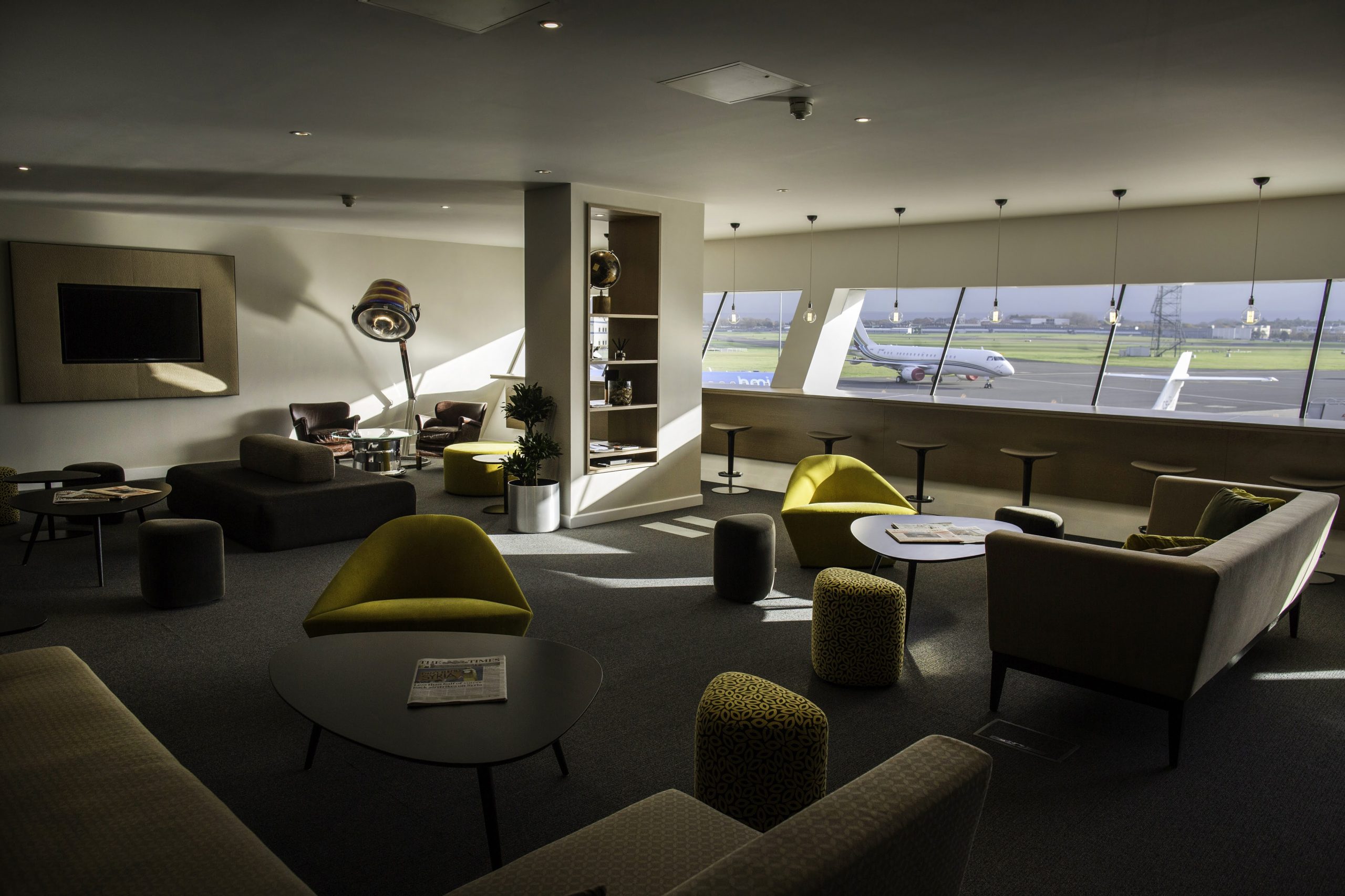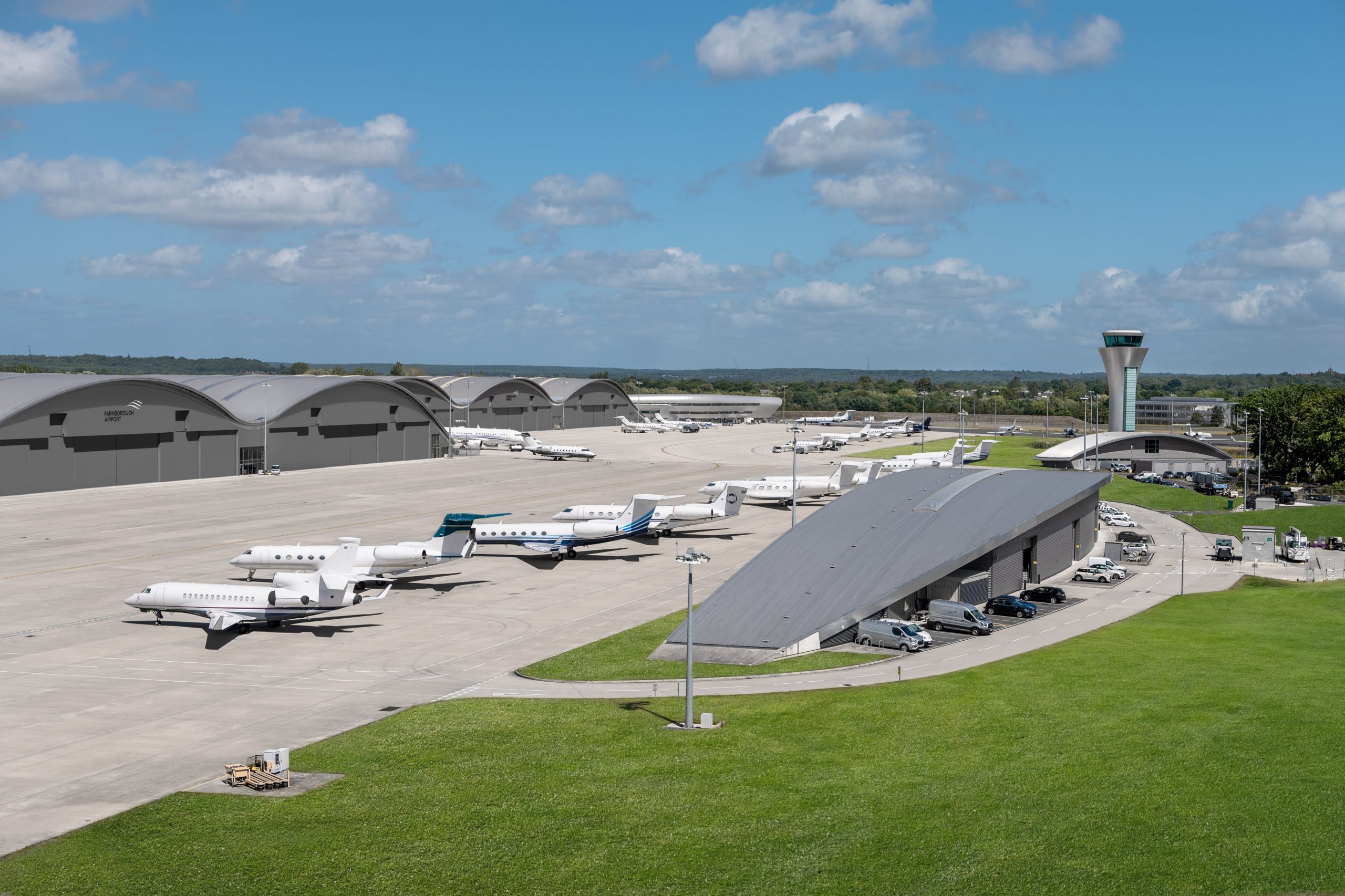What can commercial airports learn from private aviation?
By Lily Mae Pacey (International Airport Review)
13 May 2022
Shares
On a recent trip to Farnborough Airport – the birthplace of British aviation – International Airport Review’s Assistant Editor, Lily Mae Pacey sat down with its CEO, Simon Geere. Together they discussed the airport’s recent achievements in sustainability and social responsibility, and how commercial airports can learn a thing or two from the private sector and the passenger-centric values they champion.
When visiting Farnborough Airport, you cannot help but notice how much more seamless, efficient, and effortless it is to fly private. As you pass through the front doors of the terminal into a compact, clean, and minimalistic space, the absence of the typical hustle and bustle of large crowds, queuing, and rushing to find your gate, does not go unnoticed. It provokes the question, what can commercial airports learn from a private airport?
Geere has experience of both, having worked for both London Heathrow (LHR) and London Luton Airport (LTN) earlier in his career before moving across to Macquarie Group, the company that acquired Farnborough in 2019.
Speaking about his own experience in both commercial and private aviation, Geere explained how the knowledge he has acquired over the last 26 years, means he has “a foot in both camps”; and this experience has informed how he manages Farnborough Airport.
A different dynamic
According to Geere, what differentiates a private airport from a commercial airport is the absence of airlines at private airports: “In a commercial passenger airport, the airline community has a heavy influence on airport operations, including control over their own handling and fuelling companies. A commercial airport acts as if it is community landlord, as such, running the terminal and hoping to optimise retail, parking, and so forth.”
In fact, a private airport works under a very different dynamic, working to position products and outlining key value opportunities, working alongside one key shareholder, without the need for airlines, large passenger numbers, and retail. Therefore, both the operator’s and consumer passenger’s airport experience are entirely at the hands of the airport itself.
A commercial airport acts as if it is community landlord, as such, running the terminal and hoping to optimise retail, parking, and so forth”
Working with a singular shareholder allows Farnborough Airport to align on key issues and ensure a clear solution promptly. Geere further explained how the airport has “total control over the experience that the operator and the consumer passenger have, allowing us to deliver a bespoke product to the customers and at a five-star level of service.”
Passenger experience challenges at commercial airports
Currently, Geere sits on the AGS Airports board. He mentioned that upholding a quality passenger experience is a core challenge commercial airports continue to face, specifically with issues such as rising inflation, airline payments, and the gradual disappearance of duty free. “All of these queries, jolts the question of, how do you create a ‘product’ that people will want to come to you and use?”


Credit: Farnborough Airport (FAB)
As a result of low-cost airlines intentionally paying the bare minimum to airports, airports have no alternative but to provide lower quality facilities. “The feeling of glamour seems to be sucked out of the whole commercial airport process. That is what we stand against at Farnborough Airport. We can control a lot of elements, but we will continually refine and improve the levels of passenger experience and I think that is an opportunity for all airports competing against one another.”
Geere summarised that commercial airports need to focus more on the passenger experience and should target ‘premium’ attributes, that would deter customers from looking to other travel alternatives.
Movie star treatment


Credit: Farnborough Airport (FAB)
At Farnborough Airport, the passengers are treated with an exceptional level of care from the moment they walk through the terminal building. Both individuals and large groups of passengers are greeted at the door by an airport staff member and shown either to the general waiting area or a private waiting room, separated by flexible partitions, if required for larger groups. For those travelling through the airport, security and baggage screening is a singular room and passengers are called to pass through security when it is time, removing the usual airport queues and crowds. Furthermore, as an additional plus and what was most surprising during International Airport Review’s visit to Farnborough Airport, was that passengers who own an aircraft under a certain weight can drive straight onto the tarmac, without even having to enter the terminal building itself or leaving their car – a frictionless travel experience at its finest.
Providing support for staff and pilots


Staff and cabin crew resting area at Farnborough Airport (credit)
The feeling of glamour seems to be sucked out of the whole commercial airport process”
The airport’s attention to detail does not stop there. Geere believes the perfect airport experience goes beyond just passengers and is also essential to the care of flight staff, crew, and pilots: “That is why we were voted number one FBO, consistently outside the U.S. by Aviation International News and Professional Pilot magazine also, and a lot of these votes come from cabin crew and pilots who have said their airport experience is one of the key decision-makers that would bring them back to Farnborough.” The airport gained this title due to the exceptional facilities they offer to cabin crew and pilots such as a well-equipped gym, nap rooms, free use of Wi-Fi, computers, iPads and showers, all in order to ensure they are relaxed and de-stressed before their next flights.
Maintaining carbon neutrality as demand increases
In 2021, WINGX’s latest weekly Business Aviation Bulletin reported that the private jet flight demand figures for the month of June curved 12 per cent above pre-COVID levels, and private jet company, Monarch Air Group, demonstrated higher than the industry growth rate at 177 per cent year-over-year back in 2021 and projected a significant amount of growth in private aviation by the end of 2021 / beginning of 2022. With the rise in popularity for flying privately over the past few years, Farnborough Airport made it a priority to continue its sustainable journey. Back in 2018, Farnborough Airport became the first business aviation airport in the world to attain carbon neutrality under the Airport Carbon Accreditation run by Airports Council International Europe (ACI- EUROPE). However, Geere explained how investments in the airport’s facilities will enable Farnborough to maintain this achievement, as well as achieve the UK government’s Net Zero by 2050 initiative, all whilst handling increased demand in private travel.
Farnborough Airport has handsomely invested in new carbon zero-emitting technology such as electrical ground power, electrical vehicles, and, particularly, the introduction of sustainable aviation fuel (SAF), which is in high demand in the market, yet too expensive for operators to fully utilise currently, according to Geere.
The CEO’s ambitions for the airport’s sustainability, however, continue to grow: “I think the use of renewable diesel, which is the next strategy we’re going to embark on, is a game-changer for us. Any diesel, petrol-powered combustion engine will be able to use renewable diesel, hopefully, immediately reducing what is left of our carbon emissions and directly or indirectly controlling this by about 25 per cent.”


Credit: Farnborough Airport (FAB)
With ongoing plans for a third hangar to be constructed at the airport, Geere highlighted how an issue they are facing is the reduction of gas usage. He mentioned: “To provide temperature-controlled environments for aircraft, gas heating is required. At the moment, there is no technology to replace gas heating for large spaces.” Despite this set-back, Geere explained how the goal is, eventually, to embrace new ways of heating such as geothermal technology.
Although the technology for post-net-zero strategies is still at innovation stages, Farnborough Airport plans to embark on carbon capture through planting trees and utilising peat bogs. “There is a lot to do, but all extremely important to the long-term success of the airport and everything we stand for.
“We want to be the showcase for airport sustainability, as it runs throughout the DNA within our team and across the airport.”
Responsibility and inclusivity
The airport sees social responsibility as a core factor for the resounding support provided by the Farnborough community. During summer 2021 and amidst the COVID-19 outbreak, the UK government faced enquiries regarding issues with providing school meals for children. In support of the local community, Farnborough Airport’s hotel utilised their own catering facilities to provide local families with school meals.
Beyond community responsibility, Geere proudly highlighted the importance of corporate responsibility and how the airport prides itself on being a go-to employer for the community.
When he joined Farnborough Airport back in 2020, Geere noticed how incredibly proud those associated with the airport were. “The airport is not just the legacy of being the birthplace of British aviation, but people are incredibly proud of the sense of belonging.
“Our shareholder is also passionate about employee diversity and inclusion, and we want to start to elevate this in our agenda.”
According to Geere, there is still a lot of room for improvement throughout the aviation sector, as traditionally airports have been viewed as a male-dominated environment. “We are making great strides in being more inclusive and taking a more balanced approach to hybrid working, where we encourage people to come in to try to drive that team performance, but also allowing work flexibility.”
Despite a smaller organisation of 320 employees, Farnborough Airport strives to galvanise its staff members and to continue to provide a rewarding performance culture, which, unfortunately, larger corporates often struggle to achieve.
Predictions for 2022
Before the rise of the COVID-19 Omicron variant, Farnborough Airport was achieving outstanding air traffic results, of which figures did not fall short of amidst the pandemic, as many customers swiftly recognised the flexibility and reliability of flying privately. And as we speak, the airport’s air traffic figures have already returned to ‘normal’ (pre-pandemic levels) of around 32,000 to 33,000 movements a year.
With total normality in sight, the airport will be taking part in a large UK airspace modernisation programme, controlled by the Civil Aviation Authority, which aims to adjust and improve Farnborough’s aircraft movements.
Geere’s passion for his airport and for business aviation is clear.
When asked finally why he made the jump from commercial to private aviation, he answered: “The number one reason was the chance to make a difference. I’ve seen where we’ve been successful in commercial airports, and I’ve seen where we’ve been less successful. Seeing the size of the opportunity we’ve got here at Farnborough and the chance to make a difference to air travel and the passenger experience, it’s immediately compelling, isn’t it?”
It sure is.
Biography















